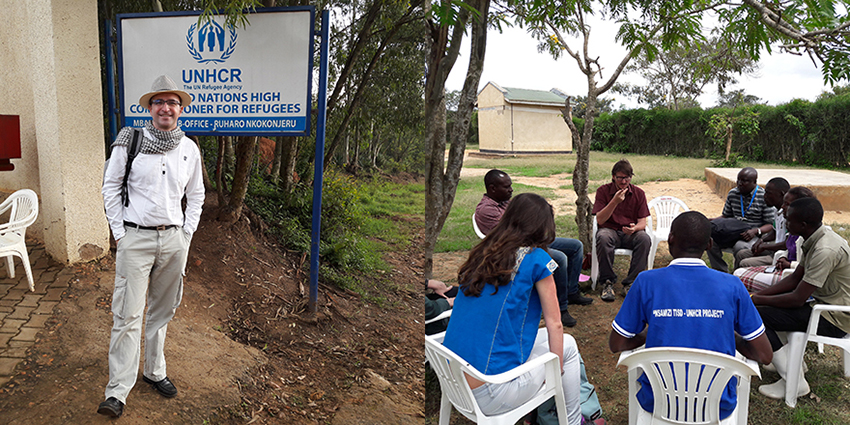Microfinance and refugees: a promising association
By Alexia Van Rij & Philippe Guichandut, Grameen Crédit Agricole Foundation

© FGCA
What if microfinance was the key to refugee integration?
Often perceived as too risky and unstable a clientele, refugees are generally not or underserved by financial service providers, despite the crying need. However, the few experiments in lending to refugees seem to show satisfactory results[1].
Based on this observation, the UNHCR (United Nations High Commissioner for Refugees) and Sida (Swedish International Development Cooperation Agency) launched a program promoting access to financial and non-financial services for refugees in Uganda and Jordan. This is how the Grameen Crédit Agricole Foundation was selected to support its partner microfinance institutions in reconsidering the refugee issue in their strategy.
An initial study on the needs for access to financial and non-financial services was entrusted to Microfinanza[2]. In this context, we spent three days of exciting discussions and meetings with Burundian, Rwandan and Congolese refugees at the Nakivale camp in southern Uganda.
In the heart of Nakivale, Uganda: a strong need for access to financial services
Uganda is now the third largest refugee-hosting country in the world, with over 1.4 million refugees as of the end of March 2018. Following the 2013 crisis in South Sudan, Uganda has seen a growing number of refugees arrive, with the UNHCR estimating the number at nearly 1,800 per day. The country has one of the most favorable refugee policies in the world, allowing them to receive a plot of land to cultivate, to work, to have free access to Ugandan social services (education, health), to enjoy freedom of movement and to receive identity papers. It is in this very specific context that the Foundation joined the Microfinanza team in Nakivale, one of the oldest refugee camps in Uganda, to support them in their study with refugees.
Nakivale is now home to over 100,000 people, primarily from Rwanda, Burundi, and the Democratic Republic of Congo, spread across small settlements across 185 square kilometers. Most of Nakivale's residents have benefited from plots of land granted by the government, used for farming and livestock breeding. Others run small restaurants, hair salons, or clothing stores. These are typical activities for microfinance institutions. However, no microfinance institutions operate in the camp, and the refugees can therefore rely only on solidarity within the camp.
Moban Sacco, a savings and loan organization that now has no fewer than 1,449 members, was born from this mutual aid effort in the face of a lack of capital. Thanks to Moban Sacco, refugees can save small amounts and receive some loans, but these are generally considered insufficient to truly develop their businesses.
Prejudices denied
One of the fears microfinance institutions have about refugees is that they will return to their country without having paid their debts. It is clear that in Nakivale, none of the people interviewed plan to return home anytime soon, given the region's insecurity. Some of them have been living in the camp for over 15 years (an average of 7-8 years) with the firm intention of developing their microenterprises there.
Furthermore, all the refugees we met stated that they had a very concrete idea of how they would use a loan. In a nutshell, it's not ideas that are lacking, but capital! How can we forget the story of this woman, who came from the Kivu region of Congo, alone with her three children, a hairdresser by profession, whose 11-year-old son translated her words because she had worked all her life to ensure that her son learned English? Having left her country with no savings, she didn't have the means to set up her hairdressing salon and depended on the food rations provided by the UNHCR to survive, she and her children. Or the meeting with this Rwandan entrepreneur, who with his few savings created a grain milling company 6 years ago? He had managed to employ 3 people to develop his activity, but his small savings did not allow him to expand his business and buy new, efficient equipment.
These examples, among many others, highlight the diversity of situations and the often wasted potential of these men and women endowed with talent, experience and the will to take their destiny into their own hands, as they had been able to do in their country before the situation got out of hand.
At the Foundation, we are convinced that microfinance institutions, by adapting their products and services, have an active role to play in promoting the financial inclusion of refugees. The opportunities offered by digital finance, a sound understanding of the characteristics of each group, and regular monitoring should foster such involvement. Meetings with the Foundation's partner financial institutions suggest that they will be ready to meet the challenge of offering quality, inclusive financial services to these refugee populations and their host communities.
The study currently underway with Microfinanza, which will be made public in July 2018, should provide concrete avenues for our partners to actively engage in, with our support, joint work with the UNHCR and technical assistance funded by Sida.
_______________________________________________________



Leave a Reply
Want to join the discussion?Feel free to contribute!